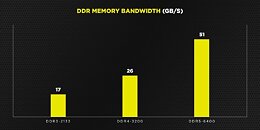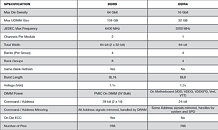Monday, May 17th 2021

CORSAIR Teases DDR5-6400 Memory Coming Later This Year
The fifth iteration of DDR technology, called DDR5, is set to arrive later this year. Many makers of DDR4 technology are announcing their plans to switch to the new standard, and CORSAIR is no exception. Known as the maker of high-quality products, CORSAIR has today posted a blog post teasing company's upcoming DDR5 products, and what they will be bringing to the table. For starters, the company has posted data about DDR5 modules that run at 6400 MHz speed, which is assumed to be the speed of the CORSAIR DDR5 modules when they arrive. At such speed, the memory can achieve a bandwidth of 51 GB/s, which is almost double the 26 GB/s that DDR4-3200 MHz memory achieves.
Another point CORSAIR wrote about is the capacity of a single DIMM. With DDR4, the company has made DIMMs that are only up to 32 GB in capacity. However, with DDR5, CORSAIR plans to quadruple that and build a single DDR5 DIMM that has up to 128 GB of memory on it. Another big point was the power required to run the new technology. The DDR4 standard required 1.2 Volts for operation, while the JEDEC specification says that DDR5 needs just 1.1 Volts to run. This will result in a cooler operation of memory modules.Of course, the DDR5 standard needs a new platform to run on. Currently, only Intel's Alder Lake-S platform will be DDR5-ready later this year, when the new standard becomes available for consumers. Additionally, CORSAIR has published more information about the benefits of the new standard, which you can see a part of below.
Sources:
CORSAIR Blog, CORSAIR DDR5 Primer (PDF), via VideoCardz
Another point CORSAIR wrote about is the capacity of a single DIMM. With DDR4, the company has made DIMMs that are only up to 32 GB in capacity. However, with DDR5, CORSAIR plans to quadruple that and build a single DDR5 DIMM that has up to 128 GB of memory on it. Another big point was the power required to run the new technology. The DDR4 standard required 1.2 Volts for operation, while the JEDEC specification says that DDR5 needs just 1.1 Volts to run. This will result in a cooler operation of memory modules.Of course, the DDR5 standard needs a new platform to run on. Currently, only Intel's Alder Lake-S platform will be DDR5-ready later this year, when the new standard becomes available for consumers. Additionally, CORSAIR has published more information about the benefits of the new standard, which you can see a part of below.
CORSAIRFURTHER REFINEMENTSDDR4 vs DDR5 differences:
With DDR5, individual modules are split into two separate channels by design, allowing for shorter traces that contribute to less latency and higher speeds when it comes to communicating with individual memory ICs on a memory module. This also allows for what's referred to as command/address mirroring since the signal from the CPU has to travel a shorter overall path to access specific banks of memory whereas in DDR4 a command/address signal had to travel through all banks of memory in a longer chain.
On DDR4, when a single bank of memory needed to be refreshed, the CPU had to wait for all banks of memory on a module to refresh before doing another read or write. With DDR5, we've got double the bank groups and when a bank needs to be refreshed only the same bank of each group is refreshed, allowing for the other memory bank groups to be accessed without the CPU having to wait.
Overall single access latency with DDR5 is relatively unchanged, while CAS Latency has increased, the overall latency of a top-tier DDR5 kit will be similar to previous generations of DRAM clocking in at 14-15ns thanks to the improvements we previously mentioned.
ON-DIE ECC
Reliability goes down as process technologies shrink, resulting in higher latency and looser timings overall at higher speeds. DDR5 features on-die ECC as part of its spec, helping to reduce errors and allow for memory ICs to operate at higher frequencies. To be clear, this doesn't mean that mainstream DDR5 is using a full-fledged ECC implementation, there'll still be unregistered modules for typical consumer applications and ECC modules for enterprise/research applications.




27 Comments on CORSAIR Teases DDR5-6400 Memory Coming Later This Year
My guess is that first gen DDR5 will not be very impressive. And due to the voltage regulation and ECC being onboard i expect DDR5 to be the most expensive main memory standard yet.
It wont be until DDR5-8000 speeds that it starts to overtake DDR4 in terms of performance and equals DDR4-3200 CL16 latency. But 8000+ speeds wont come until 2022 at the earliest. 2023 most likely.
Good article from Anandtech: www.anandtech.com/show/16143/insights-into-ddr5-subtimings-and-latencies
I know I know. just saying. meh. I'm happy with my setup, I don't intend to upgrade for a few years.
But they also add same bank refresh. unlike right now where all the memory is refreshed at the same time. This should also help to improve performance. The voltage regulator will also be on dimm so it should stabilize the voltage allowing better frequency or settings at lower voltage.
DDR5 is a big step forward versus previous DDR generation. It's not just a doubling the of the bus frequency vs the chip frequency.
And if that's the case why would Corsair of all companies say the 51GB/s number in their press release? Would they not advertise the bigger 102GB/s number instead?
Makes no sense for manufacturers to quote only single channel numbers at this stage.
DDR5 uses 4x32 bit channels instead of 2x64 bit channels. Two sticks still give you a 128 bit data bus. The 51GB/s is not from each stick beign dual channel and is rather from the 6400 mhz clock speed.Manufacturers have been quoting single stick memory speeds since forever. It's still a valid comparison, just multiply the number by 2 for your dual stick config. The DDR4 number quoted is also a single stick speed.
Yes, with custom timings and very different primary timings to the XMP spec, it's usually possible to get Corsair RAM to run at it's rated speed but it's certainly not a set-and-forget one-click job!
DDR4 at 3733 has a channel-bandwidth of 29 GB/s, and that includes CAS / RAS messages (which are important to make the RAM work, but do NOT contribute to application-level bandwidth). Two sticks of DDR4 going 29GB/s will be a little bit over 50GB/s in practice.
---------
The 51GB/s quoted here is a single-stick DDR5 channel bandwidth
the memory timing are tied to the bus speed. so at DDR5-6400, a CL of 32 is the equivalent of a DDR4-3200 CL16. The memory will response as fast with both settings but the DDR5 will have twice the bus bandwidth.
So for people that are maniac of timing, they think that DDR5 will be slower because of that. But overall, DDR5 will deliver twice the bandwidth with similar timings and we will see faster memory down the road. The fact that each DIMM have it's own voltage controller will probably even help memory overclocker and stuff.
If I understand correctly, GDDR5/6 is already very high latency so perhaps graphics cores really don't care and the three things they need most are bandwidth, more bandwidth, and even more bandwidth....Anand has a pretty good deep-dive on DDR5 and at 6400 the JEDEC specs aren't anwhere near absolute latencies of DDR4.
For single-rank, single bank, DDR5-6400, CL46 is the fastest it gets and those will be only small capacities, likely up to 8GB DIMMs. If you want more than 32GB RAM on a consumer platform you're going to be dropping to CL56.
The good news is that JEDEC spec for DDR4-3200 is CL22 and yet common retail kits were CL16 within a year or so of DDR4's launch. By that same standard, we should be seeing relatively affordable DDR5-6400 selling with CL34 or so by the time the first DDR5 platforms have matured.
I mean, it kinda-sorta matters. RDNA2 has something like 1/3rd the latency of Vega. (Vega being 300+ns to read/write to RAM, while RDNA2 has 100+ns or so). AMD clearly aimed at making their GPUs have lower latency in this latest generation. But still, they decided to have 300+ns latency originally (and Vega64 still shows how "high latency" reads/writes can be worked around by the hardware scheduler: higher occupancy or other such software+hardware tricks can mitigate that latency)
Interesting.
Also, voltage regulation is done on the DIMM instead of on the motherboard now?
The CL is just one of the various timing affecting the latency. We do not know what the other one will look like. Also, Like usual, there will be chip binning and the actual final latency at each DDR spec will probably be very similar as what is currently possible with DDR4. Even Anandtech recognize that having the voltage regulator onboard will help to get higher memory overclocking.
www.transcend-info.com/Support/FAQ-292
They list their DDR4 memory bandwidth per dimm, just like the corsair press release. And:
DDR4 data transfer rates:
DDR4 2133:17 GB/s
DDR4 2400:19.2 GB/s
DDR4 2666:21.3 GB/s
DDR4 3200:25.6 GB/s
So take that 3200mhz memory speed, double it to 6400, which this DDR5 claims to run at, and you get 51.2GB/s, the claimed speed form corsair.